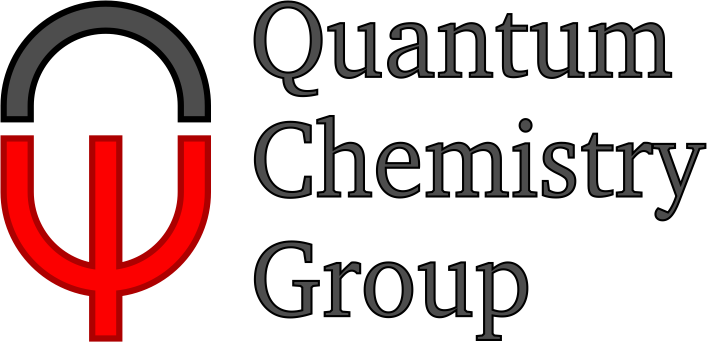Zespół Chemii Kwantowej

Quantum chemistry is about theoretical predicting of structure and properties of atoms and molecules. The fundamental equation that governs behavior of electrons – the Schroedinger equation – is far too complex to be solved exactly for real systems. Thus, quantum chemistry relies on approximate methods that, ideally, yield accurate results at bearable computational cost (“bearable” in practice may mean a few seconds or weeks). A continuous progress in this field is possible due to development of novel more accurate and more efficient computational methods. They find applications for example in characterizing and explaining properties of known molecules, designing new materials of desired properties, or in investigating mechanisms of chemical reactions. The field of application is endless but proper computational tools have to be at hand.
Many-electron methods can be roughly divided into those that aim at solving the Schroedinger equation by assuming a certain mathematical form for a wavefunction (think of the Hartree-Fock or the coupled cluster methods) and those that do not involve a wavefunction explicitly but employ less complex and easier to handle by computers functions (the most prominent example of such an approach is DFT – density functional theory – a workhorse of today’s computational chemistry).
We are developing quantum chemistry theories and methods applicable to investigate electronic structure of atoms and molecules that employ reduced density matrices or electron densities. In particular, our fields of interest include:
One-electron Reduced Density Matrix Methods
We pursue the idea of replacing the wavefunction by reduced density matrices and developing methods for ground- and excited state description of molecules. In the last few years we have been working on density matrix functional theory (RDMFT) and its time-dependent variant (TD-RDMFT) [1-3].
Range-separation methods
We also work towards exploiting the idea of range-separating electron-electron interaction into the short- and long-range regimes in predicting excited electronic states of molecules. We have proposed a theory that allows one to combine long-range density matrix functionals or long-range wavefunction methods with short-range density functionals within a linear response theory. This offers a possibility of predicting excitations unavailable in standard approaches to a widely used TD-DFT method [4-5].
Density functional methods development
Conventional density functional approximate functionals show unsatisfactory performance when applied to molecular interaction. We have proposed a DFT based method capable of describing accurately molecular interactions of different nature. The method is based on a dispersionless functional and is applicable to predicting interaction energy of two noncovalently bonded subsystems [6].
We are also interested in developing density functional methods for computing excited state energies of molecules by using variational approaches. For this purpose we employ statistical ensemble variational principle [7].
[1] O. Gritsenko, K. Pernal, and E.J. Baerends, Journal of Chemical Physics, 122 (2005) 204102; “An improved density matrix functional by physically motivated repulsive corrections”.
[2] K. Pernal, O. Gritsenko, and E.J. Baerends, Physical Review A, 75 (2007) 012506; “Time-dependent density-matrix-functional theory”.
[3] K. Chatterjee and K. Pernal, Journal of Chemical Physics, 137 (2012) 204109; “Excitation energies from extended random phase approximation employed with approximate one- and two-electron reduced density matrices”.
[4] D.R. Rohr, J. Toulouse, and K. Pernal, Physical Review A, 82 (2010) 052502; “Combining density functional theory and density-matrix-functional theory”.
[5] K. Pernal, Journal of Chemical Physics, 136 (2012) 184105; “Excitation energies from range-separated time-dependent density and density matrix functional theory”.
[6] K. Pernal, R. Podeszwa, K. Patkowski, and K. Szalewicz, Physical Review Letters, 103 (2009) 263201; “Dispersionless Density Functional Theory”.
[7] E. Pastorczak, N. I. Gidopoulos, and K. Pernal, Physical Review A, 87 (2013) 0625501; „Calculation of electronic excited states of molecules using the Helmholtz free-energy minimum principle”.
Kierownik zespołu
Realizowane projekty
Ostatnie publikacje
-
M. Hapka, E. Pastorczak, K. Pernal, Self-Adapting Short-Range Correlation Functional for Complete Active Space-Based Approximations, J. Phys. Chem. A 128(33), 7013-7022, 2024
-
D. Drwal, K. Pernal, E. Pastorczak, Multireference Correlated Oscillator Strengths from Adiabatic Connection Approaches Based on Extended Random Phase Approximation, J. Chem. Theory Comput. 20(9), 3659-3668, 2024
-
M. Matoušek, K. Pernal, F. Pavošević, L. Veis, Variational Quantum Eigensolver Boosted by Adiabatic Connection, J. Phys. Chem. A 128(3), 687-698, 2024
-
R. Zuzak, M. Kumar, O. Stoica, D. Soler‐Polo, J. Brabec, K. Pernal, L. Veis, R. Blieck, A. M. Echavarren, P. Jelínek, S. Godlewski, On‐Surface Synthesis and Determination of the Open‐Shell Singlet Ground State of Tridecacene, Angew. Chem. Int. Ed., 2024
-
Y. Guo, K. Pernal, Spinless formulation of linearized adiabatic connection approximation and its comparison with the second order N-electron valence state perturbation theory, Faraday Discuss., 2024



